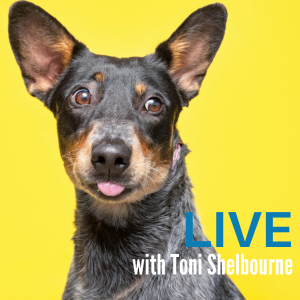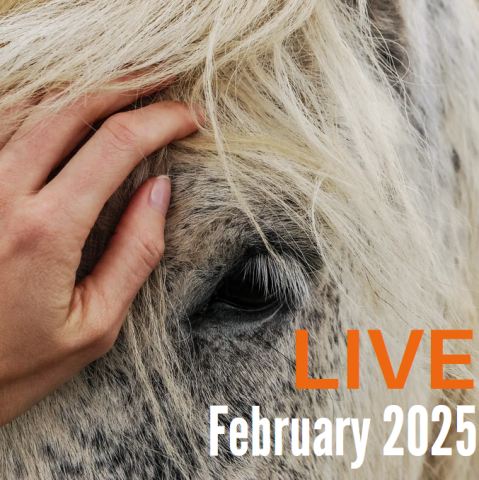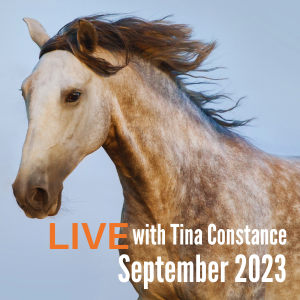Search Results
Your search for WhatTellingtonMethod returned 14 categories and 46 items
Pages
- Homepage
- Our Method for > Horses > Attend a workshop
- Our Method for > Horses > Why our Method for horses
- Our Method for > TTouch-for-You > Why TTouch-for-You
- Our Method for > Dogs > Attend a workshop
- About Us > What is the TellingtonMethod
- About Us > What is the TellingtonMethod > How to Do the TTouch®
- About Us > What is the TellingtonMethod > Examples of TTouches
- Our Method for > Dogs > Why Tellington TTouch Method for Dogs
- Our Method for > Dogs > Practitioners > Become a Practitioner
- Our Method for > Horses > Practitioners > Become a Practitioner
- About Us > Our Method
- Worldwide > What's New
- Our Method for > Dogs > Online Training
Items
About Us > Our Teachers > Meet Our Instructors
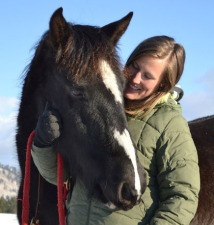
Mandy Pretty
Born and raised with horses, Mandy was literally riding before she could walk. Her exposure to the horse world was somewhat unconventional. Daughter of clinician Robyn Hood, and niece of Internationally renowned horse woman Linda Tellington-Jones, meant that her norm for handling and interacting with horses was several decades ahead of its time. Long before equine chiropractors, massage therapists and acupuncturists were main stream, Mandy and her family were looking for tangible physical and emotional reasons for unwanted behavior. They began phasing out black and white behavioral labels like “stubborn,” “lazy” and “disrespectful.” In Mandy's family, horse behavior was viewed as reaction to a concrete catalyst, requiring looking at balance, pain, fear, fear of pain and issues of rider communication.
At the age of 4 and a half, on the way to her first Advanced TTEAM® (now Tellington TTouch®) Training in Boulder, Colorado, Mandy first met Peggy Cummings, the founder of Connected Riding.
For over a decade Mandy was schooled in Centered Riding and influenced by top Icelandic riders and clinicians. She was immersed in the world of horses, helping to start youngsters, exercise sales horses as well as participating in demonstrations and competitions with some of her parents' Icelandic horses.
Then, at age 17 Mandy met Peggy Cummings again. Although initially skeptical of Peggy's Connected Riding® concepts, Mandy soon understood the influence of posture and its effect on the horse underneath. The proof was in the pudding as it were, and she was soon a “convert” to Connected Riding®. Peggy became Mandy's mentor and riding coach, expanding her knowledge of equine/rider bio-mechanics and ideal function under saddle with Connected Riding.
Mandy trains and teaches all breeds and disciplines full time; incorporating the Tellington TTouch® Method-Connect to train young horses and re-school older horses alike. In addition to training at Icelandic Horse Farm, Mandy travels to teach clinics featuring the Tellington TTouch® Method and Connected Riding. Mandy has taught independently in Mexico, Australia, the US and several Canadian provinces as well as assisting Robyn throughout Europe, South Africa, Australia and North America.
Mandy creates a positive experience for horse and rider; improving performance without compromising physical, emotional or mental well being. Her clinics easily apply to an all breed format although often geared toward the Icelandic Horse. Mandy teaches one to five-day workshops throughout the year, offering several at The Icelandic Horse Farm. She is available for demonstrations, riding lessons, lectures and clinics.
Mandy is a Tellington TTouch® Equine Instructor and a Certified Connected Riding Practitioner. She lives near Vernon, BC down the road from Robyn and Phil (aka Grandma & Grandpa) with her husband Walt and two young sons on their "Faux Farm." Visit her own website: www.intouchwithyourhorse.com.
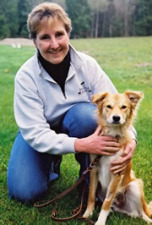
Debby Potts
For as long as she can remember, Debby knew she would spend her life working with animals. She began to live the TTouch® philosophy of creative problem solving even before she had any idea this would be her life’s work; she was extremely allergic to anything covered with hair or fur!
Of course she dreamed of having a dog. Her turtle named Herman and her canary, Tangie, were wonderful but it wasn’t the same as thoughts of walks around the block with her very own dog. One day her parents learned that poodles didn’t shed. Shoni, a silver miniature poodle, soon became her best friend.
Debby’s interest in health and well-being was sparked by her childhood companion animals, and continued with her becoming one of Oregon's first board certified veterinary technicians. She grew up breeding and showing horses, which gave her an extensive background into working with many different breeds and disciplines of horses. A horse born with severe neurological damage initially brought Debby to Tellington TTouch® Training in 1984 after the veterinarians had done all they could to help the filly. The amazing progress Spirit made inspired Debby to use the Tellington techniques to improve the lives of animals and their people on a physical, mental and emotional level.
Debby’s passion for helping people and animals in a fun, positive and creative way is evident in the many workshops and trainings she teaches every year. She has been a popular speaker at various international conferences including the Association of Pet Dog Trainers and the International Symposium on Rescue Dogs. She established TTouch® in Japan and oversees the Tellington TTouch® Companion Animal Practitioner Training there.
From the beginning, Debby has used the TellingtonMethod to help humans as well as animals. Today Debby frequently works with people to help them reduce pain, recover from illness or injury and to improve mobility and function. She finds the Tellington work and philosophy to be an important part of helping people to find balance and well being in their lives. She often says, “TTouch® isn’t just what I do, it’s who I am.” TTouch® philosophy has strongly influenced her life and that of her family. Her two wonderful sons were raised with these concepts and often asked their mom for TTouch® when they had bumps and bruises.
Debby travels much of the year teaching trainings and working privately with individuals in North America, Europe, South Africa and various parts of Asia. She lives near Portland, Oregon with her human and animal family. For more information about Debby visit her website www.IntegratedAnimal.com.
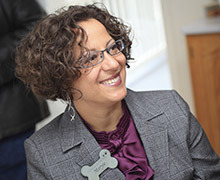
Maryse Perreault
As long as she can remember, Maryse, was always fascinated by the oneness of life and nature. As a child, following her father’s teachings, she would wander in silence in the forest, in a sort of meditative state, ‘’listening to the sound of life’’ as her father and grandfather would say. She became fascinated by interspecies bonds and relationships, including the human and companion animal bond.
What always piqued her interest was trying to understand the other and trying to establish a bond of trust without using words. As a result of this, she would unexpectedly find herself being touched by vivid emotions forming relationships that are sometimes so simple and sometimes very complex.
Later, two events brought TTouch on her path. Her dog was diagnosed with Addison’s disease, and she met with Lucie Leclerc, who was then a TTouch practitioner and assistant. These life events gave her the curiosity and interest to learn more about TTouch and it ended up completely changing her life path and career goals.
She continued her TTouch training until she became a TTouch practitioner. Up until this point, she had received her degrees in Geology and Communication but was also working, in her spare time, as a dog trainer using positive reinforcement and as an animal-assisted activities practitioner and teacher.
From then on, she dedicated her life to teaching TTouch to numerous groups of people with different backgrounds within the animal field like groomers, shelter employees, dog trainers, and animal-assisted activities practitioners, for example. She was also an active mentor to both French and English-speaking students.
She wrote articles in French for blogs, also translating numerous documents and training, and teaching online classes as well.
In her desire to better understand the TTouch method and develop her self-awareness abilities, she went on to explore the world of somatic education. She amongst other methods, explored Tai Chi, Qi Gong, Karate, the Feldenkrais Method… She ended up earning a degree in the field and now also teaches voice guided somatic work inspired by Moshe Feldenkrais in Québec, Canada.
That work, along with the TTouch work, influenced and changed the way she teaches animal-assisted activities/therapy work. She has worked with dogs, rabbits and other small animals from shelters and helping them manage their stress, anxiety and nervousness has been a growing passion from the very beginning.
As a companion animal Tellington TTouch instructor, Maryse, sees again and again how animals, like humans, possess the resources that allow them to express their full potential and their relational skills.
She is proud to partake in the changes humans are putting forward in order to collaborate and to create authentic, supportive, and respectful alliances with their pets.
For more information about Maryse, visit her website www.essenceetalliances.com or contact her directly at ttouchquebec@gmail.com.
About Us > Research & Studies
Horse 1999 EPM. Neurological Study
Tellington TTouch® as a Complement in the Rehabilitation of Horses with EPM and Neurological Deficits
The manual has been given to several veterinarians for the use of their clients and has been found very effective. Additional study and documentation required.
A study of the rehabilitation of horses with neurological deficits, using TTEAM, started through the efforts of Dr. Mark Meddleton and his wife, Becky. Becky's horse, Jewel, was severely affected by Equine Protozoal Myeloencephalitis (EPM) and Dr. Mark was trying all the forms of experimental medication. During the times that the medication seemed to be working, Becky decided to try TTEAM to rehabilitate Jewel. Becky applied her basic knowledge of TTEAM and was impressed by what she was observing with Jewel.
Becky and Mark came to a TTEAM workshop at Galisteo Creek Farms in April, 1999 to learn more and to talk with Linda to see if TTEAM would cooperate in a study of rehabilitating horses with EPM. Becky explained to the group that initially she had thought that only the ground exercises would help, but after talking with TTEAM Instructor Carol A. Lang, she tried the TTouch and realized it too was a key element.
To initiate the study, Linda and Carol met with Dr. Mark and Becky at a client's farm. A neurological exam was performed by Dr. Mark on three horses. TTEAM techniques were shown the horse's owner and Dr. Mark set up a basic schedule of rehabilitation with instructions the owner was to follow. In a few weeks, Carol met with Dr. Mark and Becky at this client's farm. Dr. Mark reexamined the horses and both he and the owner agreed that improvement had been made. Carol taught the owner more TTEAM techniques and Dr. Mark scheduled another evaluation of the horses.
In June of 1999, Dr. Mark, Becky and Carol worked with Jewel and Mark's horse, Dugan, who also had been diagnosed with EPM. Dr. Mark did a neurological exam of each horse. Then, as they did TTEAM and TTouch® with both horses, Dr. Mark, Becky and Carol discussed which techniques were working, the timing of the sessions, the sequence of TTouch® and the work in the TTEAM Confidence Course. They also made a first draft of a checklist for the owners to keep track of their horses rehabilitation program.
Carol accompanied Dr. Mark and Becky on visits to at least three clients who had horses with neurological difficulties. Each owner was shown TTEAM techniques and Becky recommended the rehabilitative process. Dr. Mark's scheduled follow-up neurological checks in order to track progress. Becky reported that the percentage of improvement of the trial horses was very high and that the owners were very satisfied with the results.
To continue the development of a protocol that Dr. Mark planned to present to the AVMA, Carol met with Dr. Mark and Becky and TTEAM Practitioner, Kirsten Henry several times over the next year. They filmed a video demonstrating how to do TTEAM techniques specifically for rehabilitation of horses with neurological deficits and developed a modified Confidence Course.
They did many trials with TTEAM techniques, in particular the use of wand and lead, the TTEAM body wrap and TTouches.
Carol prepared a booklet of TTEAM techniques to be distributed to participants of the study. Dr. Meddleton reviewed this booklet and made suggestions from his perspective as a veterinarian.
Hoping to receive a grant, Dr. Mark presented this protocol to a veterinary conference in the fall of 2000. The evaluation and advice offered about their study gave Dr. Mark and Becky new insights and direction. However, Dr. Mark's veterinarian practice was expanding so much that their time for continuing this study was curtailed.
In March, 2002 Dr. Mark reported to Carol that he could not proceed with the study of a protocol for EPM/neurologically impaired horses. He offered to share his and Becky's work with any veterinarian that Linda might find who would be interested in continuing.
We know that TTEAM has been very effective in helping horses rehabilitate from neurological deficits. We offer this booklet as a guide to TTEAM Practitioners and others who will use TTEAM and TTouch to facilitate their horses' rehabilitation.
Carol A, Lang, TTouch Instructor
Santa Fe, New Mexico
Purchase the Booklet in our Shop.
NOTE: TTEAM is an acronym of "Tellington TTouch® Equine Awareness Method." Since this article was written, the brand name for all the facets of the TTouch® organization is Tellington TTouch®.
Events
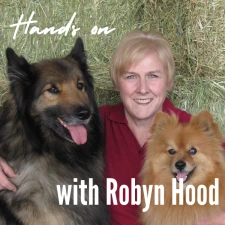
Hands On -Tellington TTouch® for Dogs
When: July 5 to 7 (3 day option) or July 5 to 9 (5 day option)
What to Expect:
- Learn the fundamentals and advanced techniques of the Tellington TTouch Method for Dogs and other Companion Animals.
- Develop skills in TTouch Bodywork, leash work, and observation to address common dog behavior issues.
- Enjoy a positive, low-stress learning environment suitable for both professionals and dedicated dog guardians.
- Gain practical knowledge to integrate into your current training program for remarkable results.
- Access opportunities to work with other species like horses in a safe, confidence-building setting.
Why Choose Us:
- Flexible tuition options, including early bird discounts and deposit plans, make attending easy.
- Receive Tellington TTouch Practitioner credits, adding value to your ongoing education.
- Tuition includes access to our exclusive Online Course – “Tellington TTouch for Dogs – An Introduction,” extending your learning beyond the workshop.
- Snacks, lunch, and refreshments provided for a comfortable learning experience.
These skills will empower you with a variety of innovative techniques and exercises to help address the most common issues confronting dog owners, trainers, and other professionals; in a forward thinking, low-stress, positive manner.
This is an ideal method to help enhance positive dog training modalities. Bring your own dog or work with one at the course. There may be an opportunity to work with other species, such as horses, in a safe, confidence building way.
Pricing:
3-Day Workshop: $775 plus 5% GST (Early Bird: $650 plus 5% GST until March 30, 2025)
5-Day Workshop: $1175 plus 5% GST (Early Bird: $950 plus 5% GST until March 30, 2025)
Deposit option available: Secure your spot with a $200 non-refundable deposit and pay the remainder at the Early Bird price by March 30, 2024.
Full Details and Registration
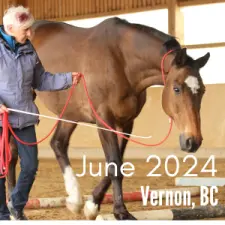
Hands On - Tellington TTouch® for Horses
Are you seeking news way of understanding or working with horses?
Would you like to learn low-stress, effective, safe and innovative techniques and exercises that can be integrated into what you already know and do?
Do you want to enhance the relationship you have with your horse?
Discover how the Tellington TTouch Method will improve performance, well-being, and behavior while enhancing the relationship with your horse on the ground and in the saddle.
This intensive hands-on course will give the tools of observation, bodywork, groundwork, and an introduction to riding concepts that will help you understand and communicate with every horse you work with.
In addition to Tellington TTouch principles we will be exploring the use of Wendy Murdoch’s “Surefoot Equine Stability Program” with a variety of Surefoot Pads and touch on Peggy Cummings’ Connected Riding concepts for body-awareness exercises that can be taken into everyday life, in and out of the saddle.
Enjoy the positive, fun filled learning environment that helps you understand and connect with horses in an all encompassing, whole, way. This workshop can serve as an introduction to the Tellington TTouch Method for Horses or as a way to build and refine the skills of more experienced students.
Choose from 2 different course options:
3 day introductory option for students new to the work and looking to add some tools to their everyday handling
5 day intensive option for students looking to deepen their understanding and refine their skills. The 2 extra days can be tailored to individual interests and learning needs.
Can count to credit for Tellington TTouch Practitioner credits suitable for new and returning students
Tuition (2 Options)
3-Day: $755 plus 5% GST (8 credits)
EARLY BIRD (Ends December 31, 2023) $650 plus 5% GST
5-Day: $1175 plus 5% GST (12 credits)
EARLY BIRD (Ends December 31, 2023) $950 plus 5% GST
Included in tuition is access to our Online Course – “Tellington TTouch for Horses – An Introduction”. $49.94 USD VALUE
Snacks, lunches and refreshments are included.
Learn more about the Facility and Accommodations.
For cancellations made more than 30 days in advance of the training, a refund will be given minus a $100 administration fee. No refunds are possible for cancellations less than 30 days prior to the start of the training, unless we can fill your spot. In some cases credit can go towards subsequent events.
We recommend that you purchase flight and hotel insurance for each event for which you register.
All prices are quoted in Canadian Dollars
ttouch.caInteractive & Online: Anxious Dogs – Understanding and Managing Anxiety
Dates: Saturdays – February 1st & 22nd, 2025
Time: 16:00 – 18:00 GMT/ 11:00 – 13:00 EST – via Interactive Zoom Sessions (recorded for repeated viewing)
Cost: $179.99
Included Content: Easy to follow, 6 lesson self-paced course! Includes many hours of video lectures and how-to video demonstrations.
Academy Credits: 4
Beginning on February 1st, join Tellington TTouch Instructor, Animal Behaviourist and Author, Toni Shelbourne as she helps you unlock the keys to understanding and supporting your anxious dog.
We all want a calm, confident canine companion. Consistent training, an enriched , low-stress lifestyle, adequate exercise and a good diet all contribute to helping our dogs feel their best; but what do you do when you come across a dog who still struggles with anxiety? As with people, anxiety is a complex issue that cannot necessarily be helped with a “one sized fits all approach” or simply additional training or exercise. This course is designed to help TTouch Practitioners and practitioners in training, rescue workers, dog owners and canine professionals gain a comprehensive understanding of anxiety in dogs.
You will acquire practical techniques in the Tellington TTouch Training method to support and manage anxious dogs. This course combines theoretical knowledge with practical strategies to empower participants in providing a nurturing and anxiety-free environment for their own canine companions, dogs in their care or clients dogs.
During the two, 2 hour live-stream sessions, Toni will guide you through the steps of understanding and then addressing your dog’s anxiety in a gentle, supportive and integrative way. These sessions are recorded for future viewing and you have lifetime access to all content.
This course include hours of informative, helpful lectures as well as easy to follow videos demonstrating specific techniques.
Full Details and Registration
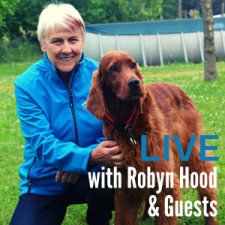
Interactive & Online Tellington TTouch® for Dogs

Join Tellington TTouch Method Instructor, Robyn Hood, as well as other guest instructors, and develop a deep level of understanding and skill that will transform how you handle and train dogs.
Enjoy the logical, linear, learning of online learning along with the inspiring and adaptive format that includes 36 hours of small, LIVE, Zoom sessions – all recorded for your convenience and on-going learning.
This course is the ideal option for anyone seeking an integrative and compassionate approach to understanding, handling and training dogs. Whether you are a professional dog trainer or dedicated dog guardian, this course will provide you with an incredible framework of philosophical understanding, observational skills, bodywork techniques, leash work exercises and innovative tools that can make what you already do well, be even better.
The Tellington TTouch for Dogs: Immersion Series can serve as your core curriculum for Tellington TTouch Online Academy Certification credits but is also a fantastic learning opportunity for those wanting to add to what they already do well or expand their knowledge and skill set in canine wellness and management.
Register and gain access to an extensive, clearly laid out and detailed online course covering the material you would learn in at least two, 5 day hands on sessions. This course can be done at YOUR OWN PACE, before or after the LIVE sessions.
Beginning in February enjoy, the first of twelve, 3 hour immersion session that will leave you inspired, empowered and excited to
Between sessions you will work on specific skills and assignments, if you are working towards Certification. Sessions are recorded for future viewing or should you have to miss a live class. Each session will be taught by Robyn or another one of our wonderful TTouch Instructors.
Enjoy the comforts of home, with your animal at ease, in this small, intimate group setting. Robyn will help coach you through specific concerns you may have and give you the tools to enhance your dog’s well being.
This course can count towards the Tellington TTouch Practitioner certification program for dogs. It is also suitable for dog guardians who are interested in the method to enhance their relationship. All levels of experience and areas of interest are welcome.
Students will have access to online material to cover at their own pace. The online portion of learning consists of a logical, linear, “Tellington TTouch for Dogs – Level 2”, which can be accessed at any time.
The online portion of the course includes:
- The FULL Tellington TTouch for Dogs Practitioner Course: Each consisting of several specific topics.
- Hours “how-to” videos and lectures about each specific concept and exercise
- Study Quiz Questions at the end of each section for your own learning
- Lesson video assignments, to be completed by those pursuing certification
- 24/7 access to all materials
The LIVE interactive portion of the course includes:
- TWELVE 3 hour sessions of learning in an intimate, supportive, group setting over the span of 6 months
- Class recordings for future viewing & review
- Access to an interactive group chat and discussion page.
- Expert feedback about your own animals
- In class assistants co-teaching and supporting the group’s learning and questions.
Payment plan available, please email ttouch@shaw.ca for information.
ttouch.ca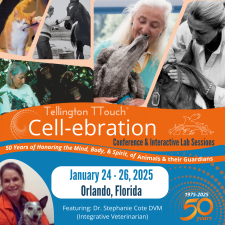
CELLebration Learning 3-Day Conference & Interactive Workshops
Celebrating 50 Years of the Tellington TTouch Method in 2025!
In 1975, Linda Tellington-Jones introduced a groundbreaking approach to influencing behavior, performance, and wellbeing in animals with the Tellington TTouch Method. In 2025 we are thrilled to celebrate 50 years of this revolutionary work!
Even though our October 2024 in-person "Cell-ebration" event was disrupted by hurricane Milton, we’re excited to transform this challenge into an opportunity:
The 2025 Tellington TTouch “Cell-ebration” Learning Conference & Interactive Workshop Sessions have been reimagined, revitalized, and ready to inspire with a completely new format!
This exciting in-person event brings together a community of passionate animal lovers for a blend of learning, sharing, hands-on practice, break out sessions, and meaningful connections.
Mornings will feature engaging lectures, including an inspiring keynote from Dr. Stephanie Cote, DVM, who integrates TTouch, Cranial Sacral Therapy, and other holistic techniques in her veterinary practice.
Afternoons will be dedicated to interactive workshop labs, where you can apply new techniques, refine existing skills, and receive personalized feedback.
Event Details:
Location: Crowne Plaza Hotel
304 West Colonial Drive
Orlando FL 32801
888-295-7563
Dates: January 24-26, 2025, Conference & Banquet
Schedule:
CELL-ebration: Friday January 24th
9:00 - 12:30 Presentations
12:30 – 2:00 Lunch at the Hotel included in tuition.
2:00 - 5:00 Interactive workshops
CELL-ebration: Saturday January 25th:
9:00 - 12:30 Presentations
12:30 – 2:00 Lunch at the Hotel included in tuition.
2:00 - 5:00 Interactive workshops
6:30-8:00 Banquet dinner (not included in tuition)
CELL-ebration: Sunday January 26th:
9:00 - 12:30 Presentations
12:30 – 2:00 Lunch at the Hotel included in tuition.
2:00 - 5:00 Interactive workshops
Note: Program details subject to change.
Fans of TTouch who are not Practitioners or have not taken any trainings, are welcome to attend the full conference.
Event Highlights
Presentations:
- TTouch & Proprioception for Dogs & Horses – Rachel Jackson
- TTouch in Rehabilitation – Karin Freiling
- Experiencing Flower Essences, Acupressure and TTouch with applied Kinesiology – Kathleen Aspenns
- TTouch Success Stories: Extreme Physical Deficits – Sanju Ramachandran
- How TTouch brings light to the cells as a form of healing communication / theory and practice – Elinor Silverstein
- TTouch Behavior Insights for Cats – Toni Shelbourne
Interactive Workshops:
- Refining & Expanding TTouch Skills with Linda Tellington-Jones
- Fascial Integration & Body Wraps with Robyn Hood
- TTouch & Cranial Sacral Therapy with Stephanie Cote & Sally Morgan
- Advanced Concepts for Dogs & Horses with Robyn Hood
- Feldenkrais Awareness Through Movement (ATM) Session
- Round Table Discussions on successes, challenges, and strategies
Participants will be grouped by experience level, creating a dynamic learning environment for both beginners and seasoned practitioners.
Join us for this extraordinary gathering as we "Cell-ebrate" 50 years of changing lives, one TTouch at a time, while honoring Linda Tellington-Jones and our dedicated teachers worldwide.
Note: Program details subject to change.
Incentive:
Bring a friend to our in-person conference (who was not previously registered to attend) you will receive an incredible bonus – of a 30-minute consultation, via Zoom, with Linda Tellington-Jones herself ($200 value)!
Payment options.
Fees: $595 if paid in full when you register
or
you can opt to pay in installments of 3 payments of $211 each (a total of $633), 1st payment due at time of registration, 2nd payment on December 6th and 3rd payment on January 3rd (the last 2 payments will be charged automatically on those days unless you contact our office with different instructions)
Tuition includes the conference and lunches. It does NOT include the Saturday evening banquet dinner.
Special Registration Fees for the CELLebration:
• Daily attendance: $245 per day (includes lunch).
• Banquet: $85 (3 course meal plus coffee and tea)
How to Register
- Below – scroll to the bottom to register and to make a payment.
- Call our office to pay with your Visa, MasterCard, American Express, or Discover card
Cancellation Policy:
Tellington TTouch Training reserves the right to cancel the CELL-ebration and trainings if necessary, because of circumstances beyond our control. In this case all deposits, tuitions and the processing fees will be refunded.
We recommend that you purchase trip insurance for your flight, hotel, etc.
Participant Cancellation Policy:
Any cancellation made more than 45 days before the start of the event will incur a $150 administrative cancellation fee. The remaining amount you have paid will be refunded to you.
For any cancellations made within the 45-day window before the event begins, whatever monies you have paid are nonrefundable, unless you are able to find a substitute participant to take your place.
Lodging
Tellington TTouch has reserved a block of rooms at the Crown Plaza Hotel at the following group room rates (The room block is under Tellington TTouch Training):
$149 plus tax in a Two Queen or King Bedroom
(Two Double Queen Beds or a King Bed with a comfortable sitting area, 48” flat screen, and workspace. A wet bar, mini refrigerator, Keurig coffee maker and full-size microwave adorns the kitchenette area. This suite sleeps 2 to 4)
Group rates include the following for overnight guests:
- Free Wireless Internet Access in all rooms
- Outdoor Pool and Hot Tub daily open from 7 AM – 11 PM
- On-Site Self-Parking – Reduced rate of $10 + tax per day
- 24-Hour Fitness Center
- 24-Hour Business Center
- Bite Bistro & Wine Bar 7 AM – 10 PM
- EV- car charging station on site
- Service Animals are accepted – no other animals allowed
- Free Hotel shuttle within 3 miles of the hotel (closest Grocery store less then 1 mile away -Publix)
Method of Reservations:
Individual reservations can be made online:
Tellington TTouch Training Reservation Link
If you need assistance, you can call Central Reservations: 888-295-7563.
(For International callers use: 407-843-8700)
Please refer to Group Reservation: Tellington TTouch Training
Check In Time: 3:00 PM Check Out Time: 11:00 AM
Please note: Reservations by attendees must be received on or before Monday, December 23rd, 2024 (the “Cutoff Date” for our room block). Reservations received after the Cutoff Date will be confirmed on a space-available basis at prevailing rates.
Please view additional Amenities at the hotel:
www.ihg.com/crowneplaza/hotels/us/en/orlando/mcooa/hoteldetail/amenities
Airports: Orlando International Airport (MCO) about 13 miles to the hotel
Shuttle: We have not been able to locate any airport shuttle but there are Uber, Lyft and Taxies. Please research your preferred option.
Things You Should Know About Orlando
Orlando is one of the most popular travel destinations in the United States.
Some interesting websites:
www.visitorlando.com
worldstrides.com/blog/2017/07/10-fun-facts-orlando/
theculturetrip.com/north-america/usa/florida/articles/15-things-to-know-before-visiting-orlando-florida
Weather:
The average weather in Orlando, Florida at the end of January is mild and comfortable, with temperatures ranging from the 40s to 70s°F
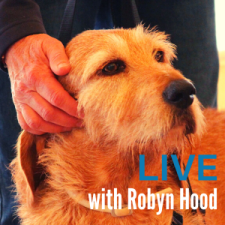
Interactive & Online Tellington TTouch for Dogs

– Are you a dog lover?
– DO you want to develop positive, effective, techniques to enhance relaxation and support well-being?
– Have you recently added a rescue or shelter animal to your family?
– Do you have a dog who needs a little extra support or has some specific challenges?
– Are you a Canine Body worker or wellness professional looking to add integrative techniques to your skills?
Join Robyn Hood (Senior Tellington TTouch Instructor), virtually, and learn trust-based, gentle, effective and supportive techniques from the comfort of home. This includes 10 hours of live, virtual, group instruction and life-time access to a self-paced online study course.
The Tellington TTouch Method is a gentle, hands-on approach that improves well-being, behaviour, cooperation and the relationship people have with animals. It includes the use of a specialized form of bodywork, specific types of equipment and creative movement exercises that are easy to learn and used with all types of animals.
Most importantly, the Tellington TTouch Method facilitates trust and enhanced communication between humans and animals. TTouch can be integrated into daily life to increase confidence, reduce stress, improve focus and enhance well-being, making TTouch perfect for busy people!
These techniques are easy to learn and provide many solutions to common concerns by recognizing each animal and person as unique individuals. Rather than a set protocol for particular issues, the Tellington TTouch Method offers creative solutions customized to each situation.
This module encompasses the “Bodywork” component of the Tellington TTouch Method, one part of the whole. This introductory module is a wonderful addition to anyone interested in canine bodywork, enhancing their relationship with their animals, those who practice canine massage, or dog guardians with senior animals looking to help enhance well-being and function.
Not sure what the time will be where you are? Check it out on our Time Zone Converter.
You will learn how to:
➔ Interpret your dog’s behavior in a non-judgmental way
➔ Notice a dog’s subtle body language for signs of stress or relaxation
➔ Use simple, relaxing body work techniques to support your dog and your relationship
➔ Support your dog with techniques to reduce anxiety and enhance self-confidence
➔ Utilize simple TTouch Body Wrap techniques in appropriate situations
➔ Recognize and acknowledge how your own state of mind will affect your dog
This workshop includes:
10 hours of LIVE, interactive instruction via Zoom
Instant, life-time access to the online course, “Tellington TTouch for Dogs: Bodywork Module” for solid foundation of knowledge and accessible review opportunities.
Supportive Study Group Access
Recorded sessions for review.
Online Course with 24/7, lifetime access.
*This course counts as 8 Academy credits towards becoming a Certified Tellington TTouch Practitioner. No prior experience with the Tellington TTouch is required.
Register and gain instant access to an extensive, clearly laid out and detailed online course. This course can be done at YOUR OWN PACE, before or after the LIVE sessions.
The class is small and allows for individualized advice and attention.
The online portion of the course includes:
8 Lesson Modules: Each consisting of several specific topics.
Over 24 “how-to” videos and lectures about each specific concept and exercise
Easy to follow mind maps
24/7 – lifetime access to all materials
Online Course Outline:
➡️ Welcome to the Course
➡️ About the Method
- Goals & Overview
- Components
➡️ Attitude & Philosophy
- Core Principles
- Staying Grounded
- The Power of Pause
➡️ Observation & Awareness
- What to Look For
- The 5 Fs
- How to Observe
➡️ The Sensory Side of TTouch: How TTouch Affects the Nervous System
➡️ Basics of Bodywork
- Understanding & Refining the TTouches
- TTouch Techniques: Part 1
- TTouch Techniques: Part 2
- TTouch Techniques: Part 3
- TTouch Techniques: Part 4
- TTouch Techniques: Extremities
➡️ All Wrapped Up: TTouch Body Wraps
- Quarter & Half Wraps
- Head Wraps
➡️ The Next Steps
ttouch.ca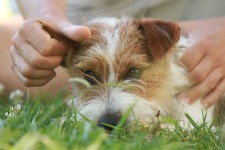
TTouch Training for Companion Animals
This class is sold out. If you'd like to be added to the wait list please contact our office with phone number and email: kirsten@ttouch.com or call us at 866-813-8169
Tellington TTouch® Training for Companion Animals in Jefferson, MD
Three-day Workshop Aug 23rd – 25th, 2024
Schedule:
Day 1: 10:00 AM-5:00 PM
(Arrive by 9:45 AM to get settled)
Days 2: 9:00 AM–5:00 PM
Day 3: 9:00 AM–3:00 PM
Tuition: $595
A $300.00 deposit is due at the time of registration to hold a space in the workshop. The balance is due July 26th, 2024. Early-bird discount: Pay in full by July 1st and receive $55.00 off.
Please note: If you pay your deposit with a credit card, any remaining balance will be charged to the same card 30 days before the start of the workshop unless you have paid in full or informed us of a different payment method.
Three ways to Register:
• Online: see form below
• Phone: Call our office to pay with Visa, MasterCard, American Express, or Discover.
• PayPal:Send payment to forum@tellingtontraining.com.
Cancellation Policy:
- Organizer Cancellation: If the session is canceled due to unforeseen circumstances or insufficient enrollment, all payments will be refunded.
- Participant Cancellation: Cancellations made more than 30 days before the workshop will receive a refund minus a $100 administrative fee. No refunds for cancellations made within 30 days of the workshop, but funds can be applied to another training within one year of the cancellation date.
Animals attending the Training: Dogs and other companion animals are welcome. Notify us when you register as there is a limit on the number of dogs. Complete and submit an Animal Profile Form one month before the workshop.
If bringing your dog:
- Only one dog may participate per day due to space constraints.
- Bring a crate, x-pen, or mat, water bowl, food & treats, proof of vaccinations or titer, and ID collar, lead, and any head halter or harness.
Guidelines to help us maintain good relations with our training facilities and partner hotels by:
- Respect facility and hotel animal policies.
- Safely contain your animal when unsupervised.
- Leave facilities and hotel rooms in their original condition.
What to Wear: Comfortable clothing suitable for bending, stretching, and sitting on the floor.
Meals: Meals are not included. Bring your own lunch and snacks. Water, coffee, and tea will be available. There will be a one-hour lunch break each day.
Travel Information:
- Airports:
- Washington Dulles International Airport (IAD) - 36 miles
- Baltimore Washington International Airport (BWI) - 58 miles
- Ronald Reagan Washington National Airport (DCA) - 52 miles
Accommodation: For nearby hotels, visit Hotels.com or check Airbnb.com or VRBO.com.
Additional Information: Frederick, MD, is only 15 minutes away, offering dining, arts, shops, and entertainment. Enjoy outdoor activities like rock climbing, canoeing, and mountain biking. Washington D.C. and Baltimore are about a 50-minute drive from the training site.
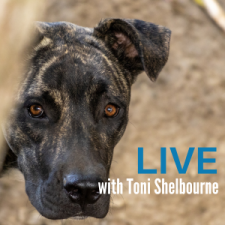
Interactive & Online: Anxious Dogs – Understanding and Managing Anxiety
Beginning on February 11th, join Tellington TTouch Instructor, Animal Behaviourist and Author, Toni Shelbourne as she helps you unlock the keys to understanding and supporting your anxious dog.
We all want a calm, confident canine companion. Consistent training, an enriched , low-stress lifestyle, adequate exercise and a good diet all contribute to helping our dogs feel their best; but what do you do when you come across a dog who still struggles with anxiety? As with people, anxiety is a complex issue that cannot necessarily be helped with a “one sized fits all approach” or simply additional training or exercise. This course is designed to help TTouch Practitioners and practitioners in training, rescue workers, dog owners and canine professionals gain a comprehensive understanding of anxiety in dogs.
You will acquire practical techniques in the Tellington TTouch Training method to support and manage anxious dogs. This course combines theoretical knowledge with practical strategies to empower participants in providing a nurturing and anxiety-free environment for their own canine companions, dogs in their care or clients dogs.
During the two, 2 hour live-stream sessions, Toni will guide you through the steps of understanding and then addressing your dog’s anxiety in a gentle, supportive and integrative way. These sessions are recorded for future viewing and you have lifetime access to all content.
This course include hours of informative, helpful lectures as well as easy to follow videos demonstrating specific techniques.
Course Outline:
What is anxiety.
Canine Communication.
Safe dog handling.
Working with the over-aroused anxious dog.
Working with the catatonic or shy dog.
What can we add to enhance our work.
What you will learn!
- Gain a comprehensive understanding of dog anxiety and its various forms.
- Learn practical strategies to reduce anxiety and create a calm environment.
- Develop skills in confidence building and calmness in dogs.
- Discover additional support options and interventions for severe cases.
- Promote the overall well-being and happiness of yours or your client’s dog.
Note: While this course provides valuable insights and techniques, it’s essential to consult with a veterinarian or professional dog behaviourist for personalized guidance in managing your dog’s anxiety.
Course Instructor:
Tellington TTouch Companion Animal Instructor Toni Shelbourne brings a wealth of experience with many different species and modalities. Toni is also an Accredited Animal Behaviourist based in the UK and has the following qualifications.
- Diploma in Canine Behaviour (ISCP Dip.Canine.Prac.)
- Tellington TTouch Instructor
- Real Dog Yoga Instructor
- Full Member of INTODogs
- Full Member of the International Companion Animal Network (ICAN)
- Senior Instructor for Dog Training College
- Author
- Over three decades of experience working with animals
Tellington TTouch® for You & Your Horse
Live Interactive Sessions for you & your horse
Dates: Saturdays – February 1, 8th, 15th & 22nd.
Time: 9:00am – 11:30am (PST) or 17:00 – 19:30 (GMT)
Cost: $249.00
Certification Credits: 8
Between the sessions you will take what you have learned and practice it with your own horses. Take video for specific feedback to share in the next class so you can refine and improve your technique. (Live sessions are recorded in case you cannot make the live time)
LIVE ZOOM sessions for further guidance and discussion of course material. Between the sessions you will take what you have learned and practice it with your own horses. Take video for specific feedback to share in the next class so you can refine and improve your technique.
Join us for a supportive, interactive learning experience that will give you the understanding and skills to start making a difference in your horse’s performance, balance, trust and well-being right away!
Enjoy the logical, linear, learning of Online Learning PLUS 10 hours of inspiring and interactive learning with 10 hours of ZOOM sessions, in 2.5 hour weekly sessions.
What You Will Learn
- This course guides you through several components of the Tellington TTouch Method for Horses.
- Discover the kind, empathetic, heart-centered, philosophy that is at the core of our approach.
- Understand how to “see your horse with new eyes” through non-judgmental, rational, methods of observation and understanding of behaviour.
- Learn the cornerstone of the TellingtonMethod, the TTouch Bodywork, simple, non-invasive and easy to learn equine bodywork that relieves tension, improves posture, increases awareness and enhances trust.
The online portion of the course includes:
- 8 Learning Lesson Modules each with a variety of focused topics
- Easy to follow mind maps and “how-to” video
- 24/7 Instant access to all materials
The LIVE interactive portion of the course includes:
✳️ 10 hours of LIVE, virtual learning in an intimate, supportive, group
✳️ Personalized coaching for your and your horse’s specific goals or challenges
✳️ A dedicated WhatsApp group for all participants for any mid week queries or discussion
✳️ Private Facebook page where the recordings of the zoom sessions will be uploaded.
Full Details and Registration
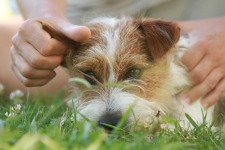
Tellington TTouch® Training for Dogs
This Workshop is Full. If you'd like to be added to the waiting list, contact us here
Three-day Workshop: May 9-11th, 2025
Instructor: Linda Tellington-Jones
Schedule:
Day 1: 10:00 AM - 5:00 PM (Arrive by 9:45 AM to get settled)
Day 2: 9:00 AM - 5:00 PM
Day 3: 9:00 AM - 3:00 PM
Tuition: $595
Deposit: $300 due at registration to hold your spot. Balance due by April 11th, 2025.
Early-bird Discount: Pay in full by March 28th to receive $55 off.
Please note: If you pay your deposit with a credit card, any remaining balance will be charged to the same card 30 days before the start of the workshop unless you have paid in full or informed us of a different payment method.
Three Ways to Register:
Online: Register Below
Phone: Call our office to pay with Visa, MasterCard, American Express, or Discover.
PayPal: Send payment to forum@tellingtontraining.com.
Cancellation Policy:
Organizer Cancellation: If the session is canceled due to unforeseen circumstances or insufficient enrollment, all payments will be refunded.
Participant Cancellation: Cancellations made more than 30 days before the workshop will receive a refund minus a $100 administrative fee. No refunds for cancellations made within 30 days of the workshop, but funds can be applied to another training within one year of the cancellation date.
Animals Attending the Training: Dogs and other companion animals are welcome. Notify us when you register as there is a limit on the number of dogs. Complete and submit an Animal Profile Form one month before the workshop.
If bringing your dog:
Only one dog may participate per day due to space constraints.
Bring a crate, x-pen, or mat, water bowl, food & treats, proof of vaccinations or titer, an ID collar, lead, and any head halter or harness.
Guidelines to help us maintain good relations with our training facilities and partner hotels by:
- Respect facility and hotel animal policies.
- Safely contain your animal when unsupervised.
- Leave facilities and hotel rooms in their original condition.
What to Wear: Comfortable clothing suitable for bending, stretching, and sitting on the floor.
Meals: Meals are not included. Bring your own lunch and snacks. Water, coffee, and tea will be available. There will be a one-hour lunch break each day.
Travel Information:
Airports:
Washington Dulles International Airport (IAD) - 36 miles
Baltimore Washington International Airport (BWI) - 58 miles
Ronald Reagan Washington National Airport (DCA) - 52 miles
We recommend that you purchase trip insurance for your flight, hotel, etc.
Accommodation: For nearby hotels, visit Hotels.com or check Airbnb.com or VRBO.com.
Additional Information: Frederick, MD, is only 15 minutes away, offering dining, arts, shops, and entertainment. Enjoy outdoor activities like rock climbing, canoeing, and mountain biking. Washington D.C. and Baltimore are about a 50-minute drive from the training site.
For more information about Fox Haven Farm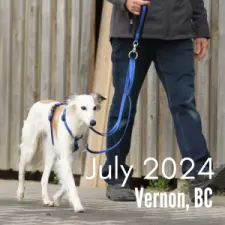
Hands On - Tellington TTouch® for Dogs
Want a calm, confident canine companion?
Looking for the skills to have more enjoyable, relaxing walks on leash?
Maybe you just want to add to your existing skills?
Enjoy the positive, fun filled learning environment that looks at dog training in an all encompassing, whole, way. This workshop can serve as an introduction to the Tellington TTouch Method for Dogs (and other Companion Animals) and build and refine the skills of more experienced students.
Professionals dog trainers and dedicated dog guardians alike will benefit from the variety of practical techniques and unique approaches learned in this class! Add layers of knowledge and skill to what you already to well and discover new ways of understanding and handling that you can integrate into your current program to achieve remarkable results.
During the session you will learn, develop and build on the fundamentals of Tellington TTouch Bodywork, Leash work, and Observation skills.
These skills will empower you with a variety of innovative techniques and exercises to help address the most common issues confronting dog owners, trainers, and other professionals; in a forward thinking, low-stress, positive manner.
This is an ideal method to help enhance positive dog training modalities. Bring your own dog or work with one at the course. There may be an opportunity to work with other species, such as horses, in a safe, confidence building way.
Can count to credit for Tellington TTouch Practitioner credits (8 or 12 credits), suitable for new and returning students.
Tuition
3-Day: $775 plus 5% GST
EARLY BIRD (Ends December 31, 2023) $650 plus 5% GST
5-Day: $1175 plus 5% GST
EARLY BIRD (Ends December 31, 2023) $950 plus 5% GST
Included in this course is our Online Course – “Tellington TTouch for Dogs – An Introduction”. $49.94 USD VALUE
Snacks, lunch and refreshments are included in the price.
Learn more about the Facility and Accommodations.
For cancellations made more than 30 days in advance of the training, a refund will be given minus a $100 administration fee. No refunds are possible for cancellations less than 30 days prior to the start of the training, unless we can fill your spot. In some cases credit can go towards subsequent events.
We recommend that you purchase flight and hotel insurance for each event for which you register.
All prices are quoted in Canadian Dollars.
ttouch.caEvents > Past Events Archive
Interactive & Online Tellington TTouch® for Horses: Intro
$279.00
September 23rd and 30th, October 7th & 14th
Live Interactive Sessions with Tina Constance
Join Tellington TTouch Instructor Tina Constance, and learn this amazing approach from the comfort of home. Enjoy the logical, linear, learning of Online Learning along with the inspiring and adaptive format of LIVE Zoom sessions.
Learn the innovative and empowering techniques and exercises that will take your relationship with your horse, to an all new level and transform the way you train horses and understand them. Whether you want guidance for improving performance, behavior, or are simply curious for a new perspective, Lindy will give you countless ways to understand, interact and influence your horse in the most wonderful ways.
Register and gain access to an extensive, clearly laid out and detailed online course covering the material you would learn in a 3 day hands-on training. This course can be done at YOUR OWN PACE, before or after the LIVE sessions.
Beginning on September 23rd; join Tina for your first interactive Zoom session. Continue each week and build on what you learn.
All sessions are recorded and sent to participants, in case you cannot make it live.
Between sessions you will take what you have learned and practice it with your own horses. Take video for specific feedback to share in the next class so you can refine and improve your technique.
This course can count as 8 credits towards the Tellington TTouch Horse Practitioner certification program for horses. It is also a wonderful learning experience for ANYONE looking to enhance their life with horses.
The Tellington TTouch Method for horses offers a handling and training approach that encourages optimal performance and well-being. Based on the understanding that behavioural issues are often caused by pain, soreness, fear or tension in the body, TTouch addresses these underlying issues through a combination of Observation, Body Work, specific Ground Exercises, and Riding With Awareness along with an overarching attitude of respect and consideration for the horse.
Schedule:
Saturday September 23rd- 16.00 to 18.30 GMT (8am to 10:30am PST)
Saturday September 30th- 16.00 to 18.30 GMT
Saturday October 7th – 16.00 to 18.30 GMT
Saturday October 14th – 16.00 to 18.30 GMT
Details and RegistrationTTouch for You: Inspiring Self Care
Connect With The Magical Intelligence Of Your Body
Tellington TTouch® is a simple, proven method of touch that has been used to improve the lives of thousands of people and animals throughout the world.
Learning TTouch® for Self-Care.Releasing anxiety and pain with TTouch® and gratitude.A supportive community sharing TTouch® in a global online setting.Connecting to the Creative Life Force in every cell in your body.The merging of science and spirituality.
This program offers credits for those looking for TTouch For You practitioner status. To learn more email kirsten@ttouch.com.
In this online, interactive course, you’ll discover what thousands have already experienced first-hand: the life-changing power of Tellington TTouch®!
$89/month or $979/yr
Dates and Times of Live Training Classes:
Each Class is 3 hours, and all classes are on Sundays at: 10:00 am Pacific Time / 11:00 am MT / 12:00 pm CT / 1:00 pm ET BONUS Weekly ‘Live With Linda’ Tuesdays each week at 11am -1 pm Pacific
Details and RegistrationOur Method for > Horses > Attend a workshop > Read More
The Touch That Teaches
In the 1980s, Equus Magazine dubbed Tellington TTouch® Training "The Touch That Teaches" and said participants will learn how to see and embrace their horse as an individual and through observation, patience and TTouch®, find the best ways to assist it in its training.
The second T in TTouch stands for "Trust" and building trust is what we aim for since it is the foundation on which everything else rests. With trust, horses learn to achieve enhanced levels of physical, mental and emotional balance.
Who Should Attend?
- Professionals of every level and from all disciplines, as well as amateurs, can benefit from learning a training philosophy and methodology devoted to working with horses using empathy instead of force - down to the cellular level. Linda's approach focuses on working with horses' minds and intelligence as much as with their body. The same is true of her work with riders.
Why Should You Attend?
- To improve your horse's rideability and performance without stress using holistic and humane groundwork, bodywork and ridden work from the TellingtonMethod and Tellington TTouch® Training.
- To create a long term training program that will help you develop a horse that is confident, willing, mentally and physically healthy, and capable of meeting your training goals regardless of discipline.
- To enhance, repair or deepen your relationship with your horse through the Tellington twin philosophies of "Change Your Mind & You Can Change Your Horse" and "Change the Posture and Change the Behavior."
What Will You Learn?
- Participants will learn how to identify, soothe and resolve discomfort in horses' bodies using TTouch. With the Tellington special ground exercises called the Playground for Higher Learning, they will learn how to help horses develop better patience, balance and suppleness as well as increase their confidence and self-reliance. They will find out why, when and how to enhance their horse's performance under saddle with the Promise Wrap, Liberty Ring, Balance Rein and Lindell, and why, when and how to ride bridleless and more.
- On day one, participating horses and riders will be assessed under saddle to determine which of the TTouches, the Playground for Higher Learning exercises and Tellington riding equipment can be helpful.
- Over the next two days Linda will teach specific TTouches and Tellington techniques appropriate to each horse's situation.
- Participants will be broken into small groups and will practice with the horses under Linda's close supervision and with the help of her experienced team of instructors.
- Participants will also experience TTouch and the Promise Wraps for themselves. Linda will share the importance of heart coherence and breath work in achieving internal balance and a closer partnership with horses in and out of the saddle.
What Will You Take Away?
Susan Gibson, publisher of Trail Blazer Magazine, reported that she left Linda's training with the "ability to see her horse with new eyes." Cristiane Pravaz from Quebec wrote after attending the Tellington Training in Hawaii; "I tried the Balance Rein with Comrade today for the first time, and I received my first half walk and a lighter trot than ever before, and when we were finished with the session, Comrade moved his head near mine and with his lips, he touched my nose and just turned like you would do to somebody to let her know that you like her and the way she rode this afternoon!!!"
Our hope and the purpose of this training is that participants will take home a different awareness of themselves and new ways to assist their horses.
Our Method for > Horses > Success Stories
Workshop attendees comment!
"This line of work has opened up a new world of alternative training which is sympathetic and supportive to the horse. The results were outstanding and immediate."
– John
"TTOUCH has awakened me to a whole new (wonderful) world. I feel things and look at things (animals, people, etc.) in a renewed and understanding way. I myself feel different too. When in a situation I handle it much differently than before. I have stopped blaming the animal/person and begun to search for the real cause of the problem."
– Sharon Crement
"A novice can do the Tellington TTouch Method It's easy to make changes very quickly even for a novice person that doesn’t do the work as effectively as an experienced person. It’s not necessary to know the work perfectly.
"It's truly amazing to be able to make changes in an animal’s behavior, physical being or mental state, and have a reciprocation take place. For every animal I see being helped by TTouch, I always feel I have learned and changed in the process as well."
- Amanda L.
"The TellingtonMethod teaches me to be a partner with my horse so I can learn to be a team. It gives me the tools to LISTEN, OBSERVE, COMMUNICATE and then give back information to our animal friends so that they can teach me to become more effective. TTouch brings joy to my horse and me."
– Amy Kendis
"This workshop has totally changed the way I view myself as a partner to my horse, our relationship and the relationship of the people and horses around me."
– Whitney Knauer
"The evening the clinic ended, my daughter was riding her Appaloosa mare (not at the clinic) in a drill team practice. The horse was a bit antsy and would not stand quietly. Rather than disciplining her as I have in the past, I spent a few minutes doing mouth work and some touches along her neck. She settled down immediately and stood quietly."
– Denise Schoenladler
"Thank you for the marvelous lessons, ideas and awareness you’ve brought to my life. My animals, family and I appreciate what I’ve learned from your lessons, patience, carefulness etc. I enjoy meeting new horses and watching, reading and understanding them because of what I’ve learned from 'Getting in TTouch' and being able to help relax, soften and relieve tension from horses whose caretakers haven’t had the chance to study and use your methods."
– Terri Rexroad
Older horses
"The TTEAM Newsletter is my “life line” to keep in touch with all the stuff you people get up to. Every now and again there is a surge of interest here in New Zealand, but for me it just keeps on getting better and better. Results mostly happen in minutes for me now, and people are amazed.
"I am always getting asked when I am going to compete my horse even though people cannot believe his age is 24 years old. TellingtonMethod had done so much for him. He had an accident 12 years ago that left him quite crippled and without the Tellington TTouch method, he would not be with me. He has taught me so much and given me some amazing experiences and may lovely rides.
"Thank you for sharing TTouch with me and many other people too. Animals, worldwide, love what the Tellington TTouch Method brings to them. And never let us forget the great job Robyn has done for so long bringing the written word to all of us TTouch people."
– Coral Boulton in New Zealand
"After seeing Instructor, Edie Jane Eaton’s demonstration, I have been using the Tellington TTouch exercises for two weeks and my l9 year old advanced dressage thoroughbred’s back is definitely more supple. And engagement is becoming elastic. He was stiff, and I have had problems getting him to use his hind-end to engage without getting stiffer in his back. No more!"
– Philippa Morrell in the UK
Shop > Horses > Books
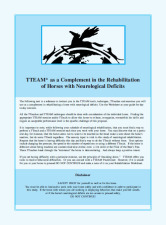
Rehabilitation of Horses - Booklet
Useful techniques to help your horse recover from neurological deficits including EPM.
Worldwide > Animal Ambassadors International
1988 Animal Ambassadors International - Pilot Program in Idaho Schools
I've just been through a remarkable experience. It actually began last fall, when I did a pilot program introducing Animal Ambassadors International® and TTEAM to elementary school children in my home state of Idaho. The TTEAM portion of the program was exciting and well received. We could see a wonderful thing happening: children becoming more responsive, more caring. We did not so much teach the children as awaken something they already had within themselves, something that can be very beautiful in a child. I say "we" because it was the animals who were the teachers. The TTouch was the connection that made it possible, but I was as surprised as anyone at some of the "lessons" the animals taught us.
We also demonstrated how an Animal Ambassadors International unit can be used to teach natural history and science. Each child chose an animal to befriend, protect, and learn more about. Many of the children also wrote a poem on behalf of their animal.
The content was rich, the program was successful and yet something was missing: the cross-cultural element Animal Ambassadors International began as an international celebration of the importance or animals in our lives. Linda Tellington-Jones invited American children to send pictures of their pet to her to take to Russia. Many children responded. The pictures were displayed in Gorky Park and the Russians were deeply touched by this expression of friendship.
I tried to introduce an international awareness into my school program, but it just didn't have the energy of the other elements of the program. In trying to analyze it and discover what was blocking the flow I realized pretty quickly that it was myself. I could not project interest in what I knew so little about. I could not make it real for them.
Fortunately a chance came to remedy the situation a little bit. On January 5, Linda organized an Animal Ambassador day for 15 Russian children who made a whirlwind tour of the US with Youth Ambassadors. Out of this experience grew the past two days and some exciting suggestions from teachers that I can hardly wait to pass on. But first let me describe what we did and what happened.
Most of the children had had at least a brief introduction to TTEAM last fall. A few had earned Animal Ambassadors International certificates. So it was a heartwarming reception I got from these children when I returned. The age range was 7 through 13, with most being 8 or 9. They were quite a bit younger than the Youth Ambassadors. But I was to find out they still responded to the Youth Ambassadors as one child to another.
I began by telling them about the Russian Youth Ambassadors in San Francisco. I told them everyday things, for example some of the comments the Russians had made about our food in the Youth Ambassador newspaper, "The Bridge." We looked at a globe to see what an immense country Russia is, and I talked about how the Soviet Union is actually many countries in one. We traced on the globe to find a Russian city exactly opposite us, only to find a city with a name we couldn't pronounce. After a few minutes' discussion I put on a record of Russian music -- explaining"balalaika" as best I could -- and then I taught the kids the dance the Russians had done the night of the concert at the Dakin home in San Francisco.
Fun? The teachers couldn't stand it. Soon teachers and aides -- everybody -- was whirling around. Nobody wanted to stop. The kids could do the difficult steps so easily it was amazing. We all had a grand time. This happened in class after class. In one class it was super because after we stopped the dancing one child said, "I wish we could write to some Russians." What a lead-in. We left the Russian musician and they wrote their letters.
The next day was thrilling because the kids had been doing some thinking on their own. They wanted to know about the Russian alphabet, why we spell their country U.S.S.R. and they write it C.C.C.P. One boy wanted to write his letter not about animals at all but about stopping nuclear warfare. I told him to give it a try if he wished, but he decided on his own that maybe his first letter should be about animals because he really had a super animal story to tell. Last fall he had adopted wolves as his totem animal and this winter he had had a chance to help a wolf. He would save nuclear disarmament for another letter.
It's important to remember that some of these letters are from kids who have never written a letter before. Many of these kids are what they used to call "under-achievers." They don't try. Well, today they tried. They tried so hard. I think they did a beautiful job. I hope it comes across how genuine and honest these letters are. The kids were not being creative, they were just being. They put their hearts into these letters and they did it in their own way, trying to be neat and readable, trying to spell the words correctly to make it easier for the Russian child who would read it. I'm not sure the Russians will understand what kind of dog a "cocker spaniel" is, but otherwise...
I wish I could put into words how important I feel this program is. These kids are not the privileged, some come to school in rags. They may never have another chance to make this connection. Yet in 10 years most of them will be voters. Will they still care about wolves and nuclear disarmament, and will they still be capable of signing "Your best friend" in a letter to an unknown Russian?
NOTE: TTEAM is an acronym of "Tellington TTouch Equine Awareness Method." Since this article was written, Linda decided to use a brand name for all the facets of the TTouch organization. Currently, that is Tellington TTouch® Training.
1988 TTEAM Gives Children Opportunities
Further Thoughts and Observations about the Opportunities that TTEAM Offers to School Children
TTEAM News International April, 1988 Vol 8 No 2 Pp. 1-6
When I began offering Animal Ambassadors International® educational programs in the schools, I had no idea what to expect. I knew that TTEAM was great for animals. Robyn's files burst with case histories of horses and other animals from all over the world that have been helped through TTEAM & TTouch. I also knew that many of these case histories had been submitted by people who had relatively little experience with TTEAM before they were called upon to use their skills on behalf of some animal in trouble. But these people were mature adults; often they were professionals in some field involving animals. The subtleties of TTEAM would not escape them.
It was different with children. I was confident that hands-on experience with live animals would provide motivation and self-esteem, and I hoped it would be a bridge to right-brain learning. But I was totally unprepared for what was to happen.
"Andy would carry the cat around upside down by the tail. I didn't like it, but I didn't know what to do about it. Then this week I noticed a big change in his attitude. He's more considerate. I'm very pleased."
This comment from Andy's father at an elementary school "Parents Night," after I had been doing a TTEAM-Animal Ambassadors International® educational program that had already run four days of a week-long unit, was one of the first hints I had that TTEAM for children is a two-way street. The benefits flow both ways. The feeling for animals that can come with actually doing the TTouch on a live animal opens up doors for some children. They begin to think in a new way that is more responsive and more caring. Many children have this natural ability within themselves, and it is wonderful to see it awakened in a child.
The key is that it happens without fuss, without preaching. The child just has a new awareness, an added element that changes the way in which he perceives the world. In some children, that is going to make a difference, as it did for Andy.
The first educational programs that I was invited to do were with children in Special Educations. As I understand it, these are children who are considered educable, but they do not learn up to their potential. Emotional and/or physical problems may be holding them back. They may be hyperactive and disruptive. Some are gifted, artistic and imaginative, but unresponsive to the left-brain learning approach favored in most schools. Some Special Ed children score high in I.Q. tests and some don't; but they are all lumped together bottom percentile and an enormous amount of effort is expended in trying to solve their problems.
If I'd had a choice, I probably would have chosen to work with mainstream classrooms or children in the Gifted and Talented programs in preference to Special Ed. However, as it turned out, that probably would have been a mistake. Each child in Special Ed is there because he or she has some kind of a problem - a problem that is considered solvable or the child wouldn't be there. So, working with 40 kids, you are going to have at least 40 problems to deal with, each one different. What an incredible laboratory for TTEAM.
Following are some examples. They are not pretentious enough to be called "Case histories" because teachers do not readily disclose a child's background unless something happens, and then they tell you as little as possible, i.e.. "He's hyperactive. He probably didn't get his pill today." The names have been changed in these examples, and anything else that might identify a particular child, as in Andy's case above. But everything else is real.
I would like to begin with an experiment in poetry writing that we did in one class. This came the day after we did an Introduction to TTEAM (with stuffed toy animals) and an imaginative journey throughout animal habitats looking for a special animal that each child could choose to befriend and protect.
Animals are now used as part of the treatment protocol in a growing number of programs, according to Carolyn Reuben, health editor of the "L.A. Weekly." She cites animals as therapy for abused children, delinquents, women in prison and the elderly. For example, animals helped abused children to relax and talk about their fears.
The last thing we were thinking about in our poetry writing class was therapy. I had read a program Mann Lowenfels does to teach creativity to gifted children and thought it would adapt well to our animal program. Simplified from Lowenfels' program, its objective was to enhance creative writing skills by giving children a simple. formula to produce a poem.
We began this lesson by asking the children if any of them had tried the TTEAM circles they had learned yesterday on their pets at home. Most of them had, and a lively discussion ensued as the children reported different reactions of their pets to the circles. The teacher then used this springboard to introduce the concept of "Feelings". She wrote several different feelings on the chalkboard: happiness, sadness, etc. Then we thought of colors, places and actions that were happy, sad, etc. You put them all together with your chosen animal and you had a poem.
And what poems did we get -- from these children who don't usually give?
Afraid is
an orange cat
In a pumpkin patch
Alone.
This is from a child who was, right then, the subject of a bitter custody fight "with many tears." Within a couple days her mother, with whom the child wanted to be, would lose the battle.
Another child from a troubled home wrote:
Mad is
a brown gorilla
Who is furious
On a volcano top.
A third child who was feared in his neighborhood because he carried a tremendous chip on his shoulder. Yet this child comes from a wonderfully supportive family. He wrote:
Happiness is
A gray wolf
In a den
With her puppies.
I think it might have been an eye-opener to some of the teachers that this child could write such a "peaceful" poem. He was showing a new side of his character, but he as also telling that his home life is okay.
Obviously the kids were projecting their own feelings into the animals that they wrote about. It was a safe way to tell us something about themselves. That may be very important for this group.
I believe now that a TTEAM & TTouch lesson, followed by a lesson in creative writing, may help children express themselves. If something is bothering them. They may choose to express their loneliness or rage in a poem. Children who bristle at the idea of writing a poem are sometimes more willing to do so if the poem is on behalf of their chosen animal. Of course, they can also write stories for their animal, as they do after Alexandra Kurland's presentations. It is possible that the animals, imagery and art all tap the right-brain mode, making for a learning approach that can release stress as well as enhance creativity.
"Animals can be some of our best teachers," Alexandra Kurland tells her audience of school children. "Every time I do a live-animal program, I find a new reason to agree with the truth of this statement. The Tellington TTouch circles that the children do open the door."
For example, a horse must be a huge animal from the point of view of a child who may never have touched a horse before. My mare, Starlite, is actually on the small side, less than 15 hands. She is 26 years old, which means that she does not move around very much. She is very pretty, with dark glowing eyes set wide apart, and a white snip and star on her kindly face. Furthermore, she just loves having TTEAM done on her. At home she has been known to "wait in line" for her turn while I'm working on another horse.
When I take her to a school, I load a portable corral on one side of my stock trailer. Starlite goes into the other aide and Lad, a dog rides in the back of the pickup. The corral is to keep the children out rather than the horse in. Some children are fearless and eager to make contact with the horse. The corral helps teachers keep them in line by setting a boundary. It also frees Starlite's head while I am working.
The children enter the corral one at a time to work on the horse. I demonstrate a particular touch, such as Raccoon circles on the ears, first getting the horse to lower her head. Then a child is invited to come into the corral and do the same thing. Most of the children love it. Their eyes are shining and they try so hard to do the TTouch exactly right. I am usually at Starlite's neck, with my arm under her neck, and I can feel her response to the children's TTouch. It is fascinating, because she seems to feel some children's hands much more than others. She will lower her head into my arm in utmost bliss. None of the children has ever frightened her or made her unhappy. It is just that some seem to reach her more.
I think a horse is the most wonderful animal teacher. Maybe it's the size that commands respect. Perhaps it in because TTEAM was originally developed for horses. The good thing is that even if a child is a little bit afraid, using the TTEAM & TTouch the child has something definite to do rather than just pet the horse and thereby, a different type of learning situation is set up. Usually the fear soon vanishes and the child is elated, with a real sense of accomplishment. Starlite feels that she knows she has given the child that good feeling. Merely petting the horse would not get the same results.
Of course, I give the bolder children a little more challenging circles than I do the shy ones. And herein lies a tale.
Bobbie was good looking, disruptive and proud. He began my day making obscene circles on his stuffed toy animal; his next move was to beat on the kids next to him. He flatly refused to do anything I asked of him and spent his time trying to make the other kids laugh -- at my expense if he could. I felt that this was not hatred but a challenge. There is a difference. I learned that Bobbie was usually taught one-on-one (that is, by himself with no other children present) and that it was only on the occasion of my visit that it was thought he might join the others. I wanted to say, "thanks a lot."
Usually with a week-long program I try to bring the horse on the first or second day. But a snowstorm delayed the live animal presentation until Thursday. By Wednesday, Bobbie was intolerable. I went to bed that night having visions of him jumping on Starlite's back, hurtling the corral and riding off into the sunset.
Actually, the next day he was pretty good. He hung on the corral with the other kids (they were allowed to stand on the first rail), raising his hand and shouting "Me" whenever someone was chosen to enter the corral. I had not worked the inside of a horse's mouth in demonstrations before, partly because Starlite doesn't like it that much, but today I did. I played the piano on her tongue. I could bear the deafening silence behind me, no "Me! Me! Me!" for this one. I did hear Bobbie say, "I'm not gonna do that!" I drew the suspense out as long as I dared and then called, "Bobbie!"
To his credit, he walked into the corral without a word. I let him suffer a moment longer and then asked him if he would like to do "Tarantula Pulling A Plow" on Starlite's back. He never said a word, and I have never seen a more focused kid. And boy, did that tarantula pull that plow! Starlite's neck sank happily into the crook of my arm.
The next day the teacher's aide who had been working with Bobbie popped out of the room, eyes wide. "He sat still for an hour! He even did his work!
Of course this was just one day in the life of this child. And we don't know quite why he was affected in this way. For some thing permanent to happen, a much more imaginative, ongoing program would have to be tried. Actually, Marie Luise van der Sode has done a six-month residential program in Europe at a Youth Farm for troubled teenage girls. She reported that some of the girls who were unpopular on account of being aggressive became easier to get along with (and more popular) after learning TTEAM. The work with the animals had taught them an alternative way of being.
Very few children have been too frightened to touch the horse and the dog. Of more than 200 children, I think only four or perhaps five hung back. One boy, Cody (the only boy who showed apprehension), conquered his fear and did very nice circles on both Starlite and Lad.
At the end of the week, the children spoke of their chosen animals in front of their classmates and other classes, and were awarded with Animal Ambassador certificates. Cody decided he couldn't do this. Cody was part of a group of mixed Special Ed and Gifted-and-Talented. The purpose of putting these two groups together was to raise the prestige and self-esteem of the slower group, to make it easier for them to leave their classrooms each day for Special Ed. Another purpose was to teach the advanced kids to share and care.
Cody agreed to let one of the advanced children read his speech for him while he stood next to the other child, holding a picture of his animal. So the advanced child practiced two speeches. Just as everyone got up to leave the room, Cody said, "I think I can do my own."
The teacher asked, "What do the rest of you kids think? Do you think Cody can do it?"
One of the advanced children started a cheer, and every child in the room took it up: "Go, Cody, Go!
Cody did give his speech, and he didn't do it too badly. As we left the other classroom, I told him, "You were brave."
He grinned one of those tooth-gaped eight-year-old grins. "Yeah, but I liked it a whole lot better being brave with the horse."
These speeches that the kids gave when they received their AAI Certificates were an exciting part of the program. One parent made the trip down to the school twice for her son's five-minute program. It was great that she was a devoted mother to do that for her son, and it also gives an indication of how much this program meant to the children. Non-readers started asking for more animal books to read. One gifted boy elected to memorize his speech, when he could have read it. Then others wanted to memorize. Another child (in Special Ed) elected to redo her project the week after I left. So there were just lots of indications that we were motivating these children.
I've found that dogs have different reasons to teach than horses. For example, Lad, Starlite's ambassador, treats each child as an individual. He'll offer a paw to one, try to lick another's face (just one lick per child), touch another's hand with his nose (one touch). Eddie, a smart, aggressive boy, was determined to make Lad shake hands with him. Before I could stop him he reached out and pumped Lad's paw. Immediately the magic left. Lad didn't exactly turn into a pumpkin, but he lost confidence for a little bit. It was a wonderful opportunity to learn myself and to explain to the children that one big part of communicating with animals is to watch and listen for the signals they give you. Of course this can be a step toward learning how to communicate more sensitively with people.
Incidentally, when I began these programs, I felt that learning care and consideration for animals could be a step toward learning care and consideration for other people. A psychologist pointed out that such was not always the case. Some people who relate well to animals do not always relate well to human beings. The animal in this type of situation are a social crutch.
Frank was a child like that. He had a brilliant mind, four pets at home, and he knew more about some kinds of wild animals than I did. He did a super job with the horse. He was wonderful with Lad. But his teacher said that be was verbally abusive to other children, with sexual connotations.
We tried to provide Frank with an alternative way of being by encouraging him to share his tremendous fund of knowledge of animals in the classroom. Understandably, the other children weren't really crazy about Frank, but by the end of the week he was providing other children with information about the animals they had chosen, and starting some interesting discussions. So in this way the animals he loves could be a bridge rather than a crutch.
When you do TTEAM it is like dropping a pebble in a pond. There is a saying that the ripples will eventually be felt on the farthest star. Lad was a dog I borrowed from a mountain man who was not known for his kindness to dogs. Since I have been using Lad for TTEAM work this man's natural kindness has surfaced. He just had never seen dogs as feeling, hurting beings before. They were curs to be yelled at and cowed into submissive obedience. Now he talks to them.
TTEAM is fascinating because you don't know what the results will be or how far they will carry. Its therapeutic value would be somewhat different that the proven stress-reduction that comes from petting an animal. My personal feeling is that TTEAM provides an ideal whole-brain learning situation. You have much more active, focused communication than when patting an animal because you are asking a great deal more of the animal. The animal is more focused because it doesn't know exactly what will come next. Some horses in particular become quite fascinated. They are so involved and politely interested in what you are doing sometimes it is almost comical.
But while you and the animal are focused, you are also very much aware of your surroundings. You have to be aware when working with a horse. An element of personal safety in involved and a sense of where you are in space is a necessity. Thoughts and movements become more precise and clear with experience.
Experiments have suggested that babies learn beat when they are relaxed, happy and alert. I see no reason to believe that animals don't learn the same way, and human beings of whatever age. TTEAM helps to promote this state where learning can happen.
New Program
This spring I am offering a follow-up program directed toward the intentional aspect of Animal Ambassadors International®. This program takes 1-2 hours. Children are introduced to the culture of a foreign country. They write letters about themselves and their pets, or stories about a favorite any species, to be shared with children in the other country.
Regards, Ann Finley
NOTE: TTEAM is an acronym of "Tellington TTouch Equine Awareness Method." Since this article was written, Linda decided to use a brand name for all the facets of the TTouch organization. Currently, that is Tellington TTouch® Training.
1993 Animal Ambassadors International in Syria
TTEAM News International Summer, 1993 Vol 13 No 2 Pp. 1-3
What on earth were we doing in Syria in April?
Off on another Animal Ambassador journey: weaving the webs of friendship between lovers of animals. Some of you will remember that before the Iron Curtain fell, I was teaching and building bridges-of-understanding between horseman and horsewomen, working with veterinarians, zoo personnel, Olympic riders, and a very special group called the Club Healthy Family.
In 1984, upon the culmination of my first trip to Moscow, the birth of the phase ANIMAL AMBASSADORS, in recognition of the unique role animals were playing in opening so many impenetrable doors inside the then Soviet Union.
Then in 1985, the birth of the Animal Ambassador concept of taking an "inner journey" to find an animal as a personal teacher. In Gorky Park, that spring, I led a group of 165 Russians, ages five to about sixty-five, on an "inner journey" to find the animal who would be their inner teacher, using the Native American model of an animal's totem as protector. My friend, Andre Orlov, translated into Russian for me. It was Andre who added the unique idea that we, in turn, must reverse the role and become "protectors of the animals". We must become their "totems."
Now, that same concept leads me into the Middle East, looking for way, to bridge the cultural gaps in that ancient area of the world, which is currently the "hot spot".
In February, at the suggestion of my friend Joan Ocean, Carol Bentley and I journeyed to Israel to join an international conference: "Prayers for Peace in the Middle East". (Some of you may have read Joan's inspiring book describing her work with dolphins.) We spent several days with my Russian friend, Alya Gurevitch, founder of the Club Healthy Family, now immigrated to Israel to work with Israeli and Arab children.
After spending time in Israeli, we decided that we also needed to meet with the Arab peoples. Having been informed it would take days to get a visa to Egypt, and having been warned travel was somewhat dangerous, a lovely woman attending the conference informed us we could simply fly to Egypt and get a visa at the Cairo airport. Sure enough, we disembarked after a one hour comfortable flight from Tel Aviv, and spent a magical three days in Cairo which, in terms of richness, could have been three months. I was completely unprepared for the welcome, for the hospitality, the friendliness we encountered.
One of the most striking impressions in Cairo was the inordinate number of animals throughout the city. Donkeys, horses, camels and buffalo make up a surprising percent of the population. Most of the horse we saw looked to be in reasonable health, although the image of a 900 pound horse straining with every ounce of his energy to pull a wagon brutally overloaded with metal rods remains fixed in my head. Thanks to Princess Alia el Hussein's influence, the condition of the horses at the pyramids has apparently been considerably upgraded. Princess Alia's Egyptian mother also supports the remarkable Brooks Animal Hospital in Cairo. Injured, exhausted and worn out animals from the streets of Cairo are brought to this hospital: there is no charge for care, and the sympathetic veterinarians sometimes take in animals just for rest. They often buy donkeys or horses who are no longer in condition to continue, and need to be put down out of kindness. They are kept in special "yard" or paddock, where they are fed and loved for a few days before they are sent on to the "pastures in the sky".
Flying out of Cairo, I wondered why this magic carpet trip?
What was I really doing there? I pulled my trusty Macintosh Power Book out of its case at my feet, while forming in my mind the image of a circle of animals which I refer to as "The Animal Council". The screen lit up with this suggestion: I should plan an Animal Ambassador Celebration in honor of the role of which horses, camels and donkeys play in the Middle East with the aim of unifying Arabs and Jews beyond, and outside of politics. I simply began to write about the next steps in the Middle East.
At first, I was shocked by the seemingly impossible idealism of such a task. However, before my first trip to Moscow nine years ago, I was assured that I would never be able to meet the Russian populace, and would have to be content with only reaching government officials. Nevertheless, in complete trust, I decided to simply begin to take small steps: see where the path would lead, and let the animal ambassadors open the doors.
Because of the remarkable synchronicity which so often occurs in my life, sharing some of the steps with you is fun, and I think this synchronicity has a tendency to happen even more frequently when it is acknowledge and appreciate.
Christine Jurzykowski, founder of Fossil Rim Wild Life Center, and a dear friend, is on our Animal Ambassador Board of Directors. Whilst at Fossil Rim in February, working with two of their young and very wild cheetahs, I mentioned to Christine that I intended to go to Jordan and Syria and, hopefully back to Israel in April. So would she like to come? Christine was to speak at a conference in Denmark the day before my scheduled departure from Frankfurt, so it seemed natural to have her join me.
The next pieces of the puzzle were held by Gabriella Boiselle, one of Europe's very best photographers, known for her exquisite portrayals with a very special "feel" - a view which no other horse photographer has managed to capture. During Equitana, Gabriella asked me what I was doing. I told her I was hoping to visit Jordan over Easter, but all the seats were booked due to the holidays. She said, "Don't worry. Princess Alia El Hussein is a friend of mine and would be fascinated by your work. I'll call her".
Two days later, Gabrielle had managed to get the seats on Royal Jordanian Airlines, organized the trip to Jordan and Syria for us; and had contacted a Syrian friend, Basil Jadaan, whom she had met at a WAHO horse show in Cairo.
Basil Jordan was one of the kindest, most hospitable gentleman I have had the pleasure of encountering in a longtime. He is establishing a troupe of pure Arabs which, approved by WAHO (World Arabian Horse Organization), and they are beautifully maintained. He hosted us on the first afternoon, seated in a Bedouin tent on cushions laid upon carpets on the ground, with glasses of hot, sweet tea and the traditional welcoming sips of very black, Arab coffee served, thank goodness, in tiny cups. The horses were paraded one by one in front of the tent, where Gabrielle photographed from all angles; she also got some photos of me working.
Our second day there, Basil's friend loaded up four horses and trucked them out of the city into the desert where we galloped and whirled for Gabrielle's cameras. She is the most entertaining photographer and personality imaginable; a live wire, with beautiful blond often wild hair which charms every man who comes within 20 feet of her. We all had a marvelous time working with her.
We drove from Damascus to Amman, Jordan, crossing the border in the record time of one hour, to keep our first appointment with Princess Alia. Princess Alia is a warm, lovely, intelligent woman.
She was most interested in the TTEAM work. She greatly honored us with a Bedouin meal in a beautiful tent set out in spring-green barley fields near the royal racetrack. Horse after horse was paraded before us prior to sitting down to a traditional meal of boiled lamb on a bed of rice, eaten with the hands. It is a rare occasion to be treated to this ancient way of eating.
We had a long discussion about TTEAM work and some of the horses which I was to work on the following day. We were awakened bright and early by the 5 a.m. call to morning prayers which resonates over the hills of Amman, and we arrived at the Royal Stables in plenty of time to catch the early morning light which Gabriella so loves. I worked with Princess Alia's veterinarian, a young Iraqi woman who was very interested, very kind to the horses, and very intelligent.
Princess Alia has some favorite horses, one of which was a young stallion, a very bad stall walker. And one of the tensest horses I have worked with. He's the first horse whose ears I could not get to in the short time we had; which, to me, is a very good indication of a tense condition in the rest of the body. I left the veterinarian with suggestions for working him, and am invited back to teach a group of veterinarians and horse owners who are gathering for an annual Arabian Horse Show by invitation of King Jussein in September. We're working to see if we can put together a clinic in time to include it with the September show.
In 1969, Went and I organized the first North American Endurance Ride Conference at Badger, California. The Jordanians are interested in endurance riding, so I am working with Catelyn O'Reardon to see if we can get a conference together in time. Catelyn was the executive secretary for the Great American Horse Race from Syracuse, N.Y. to Sacramento, California in 1976, when I was the international coordinator. So, we are going to see what we can arrange in the Middle East with veterinarians and some top, experienced riders from the US and Europe, to join together, rather than competing. Each team of three to be composed of two Arabs from two different countries with an experienced endurance rider from either Europe, or the US.
It's a great Animal Ambassador project which could result in opening many new doors towards understanding and cross-cultural pollination.
LindaTellington-Jones from Fayence, France
NOTE: TTEAM is an acronym of "Tellington TTouch Equine Awareness Method." Since this article was written, Linda decided to use a brand name for all the facets of our organization. Currently, that is Tellington TTouch® Training.
1988 The Animal Council
This report comes to you direct from the Animal Kingdom! What do I mean? Well, I had planned to write a detailed report of the Pt. Reyes week-long training, the fun, the "dolphin games" we play, the steps necessary with unusually difficult horses to make the transition from the ground exercises to riding. But I ran into blocks all day while I was writing the report. My computer disk was full. Then I couldn't find an empty disk. My printer started printing some strange computer language that not even my brilliant sister could have figured out. What was going on?
Well, I finally got it. You see, I have this funny connection to the animals. Often in my mind's eye - in bright daylight - not only in dream time, I get a picture of a circle of animals sitting together concentrating on sending me messages. Actually, they send them out to everyone who will listen. But I seem to have a mainline of communication to them. How lucky it's not on AT&T or the bill would be enormous!
They were telling me they wanted the Animal Ambassador report printed. Ah, said I, as I finally got the message.
I've been getting this communication for many years. It was back in 1969 that it first began. I was giving a lecture on endurance riding at Prescott College to a very large audience one evening. Out of the blue, I had a feeling I should use the opportunity to begin with some inspirational words in appreciation of the gifts our horses bring to us - and of the gift of nature. I stepped out of the back door of the auditorium and spread my arms in greeting to the sinking sun, asking for some guidance.
A whole flood of information came to me, but did not begin to sink into my consciousness until the drive back across the desert the following day.
What came to me was similar to a dream. I saw a whole plan similar to a blue print of my life which would unfold over many years of my life and would include school programs and camps where animals would be the teachers to children.
There have been many steps along the way: the first one being to set off to Europe in 1974 to find out how I could create a program which would bring a special appreciation for the animals in our lives (all animals not just the horses I worked with all my life).
The second step was developing TTEAM. The third was returning from Europe in 1980 and meeting Peter Caddy from Findhorn. Peter said, "Linda, I know what your Mission is on this earth. You're here to explore the relationships between mankind and the animal kingdom."
Then came my trips to the Soviet Union and the magical, and at that time, unusual connections to grassroots citizen through the animals. The Animal Ambassador concept began to take form, and I saw the excitement it generated. Alexander Zguidy, a Russian film producer, immediately saw the possibilities and said he would like to take the idea to the U.N. Alexander and his wife, Nana, have produced over 20 award-winning motion pictures with animals as heroes. I know they also have a direct line to the council of animals who guide me.
The next steps are in process in the U.S. school systems. Alexandra Kurland in New York state and Ann Finley in Idaho are taking the program into schools. Alexandra likes to be known as the spokesperson for Kenyon, known to the world as a stuffed bear, but many of us know he's much more than that. He actually is one of the reps for the Animal Council. If you would like to get to know Kenyon better write to Bear Hollow Press, 110 Salisbury Rd., Delmar, N.T. 12054 for a copy of Teddy's To The Rescue by Alexandra Kurland - a lovely children's book.
Ann is coordinating the "Animal Ambassador research and development for schools" program. In January I organized an Animal Ambassador day for a group of 15 Russian school children who were invited to the US by Youth Ambassadors, headed by Linda and Ed Johnson. They were hosted in San Francisco by Henry Dakin of the Dakin Toy Company who makes many of the wonderful toys we use for teaching the TTouch with stuffed animals.
I invited Ann to join us for the day so she could get a connection to the Soviet Union to share with her children in Idaho. We spent the day with a 4-H group of children and their parents and teachers at Point Reyes Station, California. The 4-H children demonstrated their animals and explained how they trained them and I gave a short demo of TTEAM. The Russian children were given honorary memberships to 4-H, and several of the Pt. Reyes 4-H'ers spoke the 4-H pledge in Russian.
NOTE: TTEAM is an acronym of "Tellington TTouch Equine Awareness Method." Since this article was written, Linda decided to use a brand name for all the facets of the TTouch organization. Currently, that is Tellington TTouch® Training.
